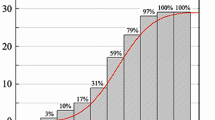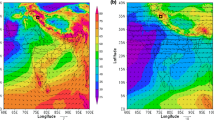Abstract
The development of a thunderstorm cell in the Beijing area according to the results of numerical modeling and field observations is considered. Based on the numerical simulation, it is shown that the most intense electrification process is the separation of charges as a result of collisions of hailstones and cloud crystals. Using the field observations, the relationship between the electrical and radar characteristics of the cloud was investigated. It is demonstrated that the highest positive correlation is observed between the frequency of discharges and the volume of the supercooled part of the cloud above the 0°C isotherm, and the highest negative correlation is revealed between the frequency of discharges and the maximum current in a discharge.



Similar content being viewed by others
REFERENCES
N. E. Veremei, Yu. A. Dovgalyuk, M. A. Zatevakhin, A. A. Ignat’ev, V. N. Morozov, and R. S. Pastushkov, “Description of the Base Numerical Nonstationary Three-dimensional Convective Cloud Model,” Trudy GGO, No. 582 (2016) [in Russian].
V. V. Voevodin, S. A. Zhumatii, S. I. Sobolev, A. S. Antonov, P. A. Bryzgalov, D. A. Nikitenko, and K. S. Stefanov, The Practice of “Lomonosov” Supercomputer. Open Systems (Otkrytye Sistemy, Moscow, 2012) [in Russian].
Yu. A. Dovgalyuk, N. E. Veremei, M. A. Zatevakhin, A. A. Ignat’ev, A. A. Sin’kevich, and M. L. Toropova, “An Example of Results of Computing Evolution of Precipitating Convective Cloud with the Complete Three-dimensional Model,” Trudy GGO, No. 582 (2016) [in Russian].
Yu. A. Dovgalyuk, N. E. Veremei, A. A. Sin’kevich, Yu. P. Mikhailovskii, and M. L. Toropova, “Studying the Dynamics of Electrical Structure for the Thunderstorm with Hail Using Three-dimensional Numerical Modeling (A Case Study for Northwestern Russia),” Trudy GGO, No. 591 (2019) [in Russian].
Yu. P. Mikhailovskii, “On Verification of Numerical Models of Convective Clouds Based on Airborne Data on Electrification,” Trudy GGO, No. 580 (2016) [in Russian].
Yu. P. Mikhailovskii and L. V. Kashleva, “Methods and Results of Studying the Electrification of Convective Clouds Using Aircrafts,” in Trans. MGO “Radar Meteorology and Weather Modification” (MGO, St. Petersburg, 2012) [in Russian].
Yu. P. Mikhailovskii, A. A. Sin’kevich, S. D. Pawar, V. Gopalakrishnan, Yu. A. Dovgalyuk, N. E. Veremei, E. V. Bogdanov, A. B. Kurov, A. Kh. Adzhiev, A. M. Malkarova, and A. M. Abshaev, “Investigations of the Development of Thunderstorm with Hail. Part 2. Analysis of Methods for the Forecast and Diagnosis of the Electrical Properties of Clouds,” Meteorol. Gidrol., No. 6 (2017) [Russ. Meteorol. Hydrol., No. 6, 42 (2017)].
A. A. Sin’kevich, Yu. P. Mikhailovskii, Yu. A. Dovgalyuk, N. E. Veremei, E. V. Bogdanov, A. Kh. Adzhiev, A. M. Malkarova, and A. M. Abshaev, “Investigations of the Development of Thunderstorm with Hail, Part 1: Cloud Development and Formation of Electrical Discharges,” Meteorol. Gidrol., No. 9 (2016) [Russ. Meteorol. Hydrol., No. 9, 41 (2016)].
A. A. Sin’kevich, Yu. P. Mikhailovskii, S. Yu. Matrosov, V. B. Popov, V. S. Snegurov, A. V. Snegurov, Yu. A. Dovgalyuk, and N. E. Veremei, “Relationships between the Structure of Convective Clouds and Lightning Frequency Derived from Radiophysical Measurements,” Meteorol. Gidrol., No. 6 (2019) [Russ. Meteorol. Hydrol., No. 6, 44 (2019)].
V. N. Stasenko, Radar Investigation of Multi-cell Convective (Thunder) Clouds (Gidrometeoizdat, Leningrad, 2004) [in Russian].
N. S. Shishkin, Clouds, Precipitation, and Thunderstorm Electricity (Gidrometeoizdat, Leningrad, 1964) [in Russian].
L. D. Carey and S. T. Rutledge, “The Relationship between Precipitation and Lightning in Tropical Island Convection: AC-band Polarimetric Radar Study,” Mon. Wea. Rev., No. 8, 128 (2000).
C. Farnell, T. Rigo, and N. Pineda, “Exploring Radar and Lightning Variables Associated with the Lightning Jump. Can We Predict the Size of the Hail?”, Atmos. Res., 202 (2018).
C. Farnell, T. Rigo, and N. Pineda, “Lightning Jump as a Nowcast Predictor: Application to Severe Weather Events in Catalonia,” Atmos. Res., 183 (2017).
T. Fehr, N. Dotzek, and H. Holler, “Comparison of Lightning Activity and Radar-retrieved Microphysical Properties in EULINOX Storms,” Atmos. Res., No. 2, 76 (2005).
B. Gungle and E. P. Krider, “Cloud-to-ground Lightning and Surface Rainfall in Warm-season Florida Thunderstorms,” J. Geophys. Res., No. D19, 111 (2006).
A. Karagiannidis, K. Lagouvardos, S. Lykoudis, V. Kotroni, T. Giannaros, and H.-D. Betz, “Modeling Lightning Density Using Cloud Top Parameters,” Atmos. Res., 222 (2019).
D. M. Lal and S. D. Pawar, “Relationship between Rainfall and Lightning over Central Indian Region in Monsoon and Premonsoon Seasons,” Atmos. Res., No. 4, 92 (2009).
X. Li, Y. Pan, and Z. Mo, “Joint Effects of Several Factors on Cloud-to-ground Lightning and Rainfall in Nanning (China),” Atmos. Res., 212 (2018).
C. Liu, D. J. Cecil, E. J. Zipser, K. Kronfeld, and R. Robertson, “Relationships between Lightning Flash Rates and Radar Reflectivity Vertical Structures in Thunderstorms over the Tropics and Subtropics,” J. Geophys. Res., No. D06, 117 (2012).
D. R. MacGorman and W. D. Rust, The Electrical Nature of Storms (Oxford Univ. Press, New York, 1999).
S. D. Pawar, D. M. Lal, and P. Murugavel, “Lightning Characteristics over Central India during Indian Summer Monsoon,” Atmos. Res., 106 (2012).
A. T. Pessi and S. Businger, “Relationships among Lightning, Precipitation, and Hydrometeor Characteristics over the North Pacific Ocean,” J. Appl. Meteorol. Climatol., No. 4, 48 (2009).
W. A. Petersen, H. J. Christian, and S. A. Rutledge, “TRMM Observations of the Global Relationship between Ice Water Content and Lightning,” Geophys. Res. Lett., No. 14, 32 (2005).
W. A. Petersen and S. A. Rutledge, “Regional Variability in Tropical Convection: Observations from TRMM,” J. Climate, 14 (2001).
F. Wang, X. Qie, D. Wang, and A. Srivastava, “Lightning Activity in Tropical Cyclones and Its Relationship to Dynamic and Thermodynamic Parameters over the Northwest Pacific,” Atmos. Res., 213 (2018).
J. Wang, S. Zhou, B. Yang, X. Meng, and B. Zhou, “Nowcasting Cloud-to-ground Lightning over Nanjing Area Using S-band Dual-polarization Doppler Radar,” Atmos. Res., 178–179 (2016).
K. Wapler, “The Life-cycle of Hailstorms: Lightning, Radar Reflectivity and Rotation Characteristics,” Atmos. Res., 193 (2017).
F. Wu, X. Cui, and D. A. Zhang, “Lightning-based Nowcast-warning Approach for Short-duration Rainfall Events: Development and Testing over Beijing during the Warm Seasons of 2006–2007,” Atmos. Res., 205 (2018).
Q. Zeng, Z. Wang, F. Guo, M. Feng, S. Zhou, H. Wang, and D. Xu, “The Application of Lightning Forecasting Based on Surface Electrostatic Field Observations and Radar Data,” J. Electrostatics, No. 1, 71 (2013).
Funding
The research was supported by the Russian Foundation for Basic Research (grants 17-05-00965, BRIKS_t 18-55-80020) and China grant 2018YFE101200 and was performed using the resources of the Lomonosov Moscow State University supercomputer system [2]. The results of the study were obtained using the computing resources of the supercomputer center of Peter the Great St. Petersburg Polytechnic University (http://www.spbstu.ru).
Author information
Authors and Affiliations
Corresponding author
Additional information
Russian Text ©The Author(s), 2020, published in Meteorologiya i Gidrologiya, 2020, No. 10, pp. 63-72.
About this article
Cite this article
Dovgalyuk, Y.A., Veremei, N.E., Sin’kevich, A.А. et al. Investigation of Electrification Mechanisms and Relationship between the Electrical Discharge Frequency and Radar Characteristics of the Thunderstorm in China. Russ. Meteorol. Hydrol. 45, 712–719 (2020). https://doi.org/10.3103/S1068373920100052
Received:
Revised:
Accepted:
Published:
Issue Date:
DOI: https://doi.org/10.3103/S1068373920100052




